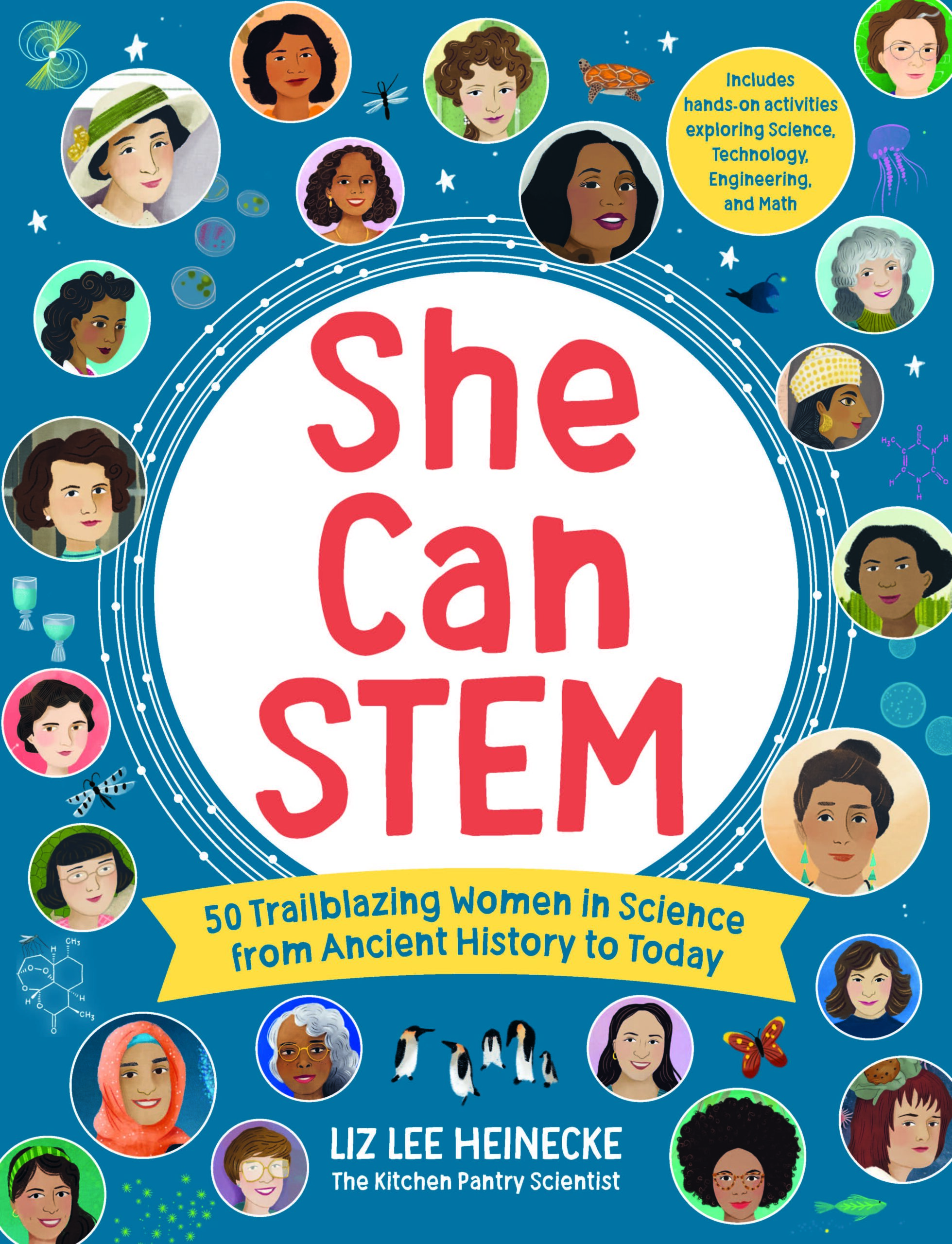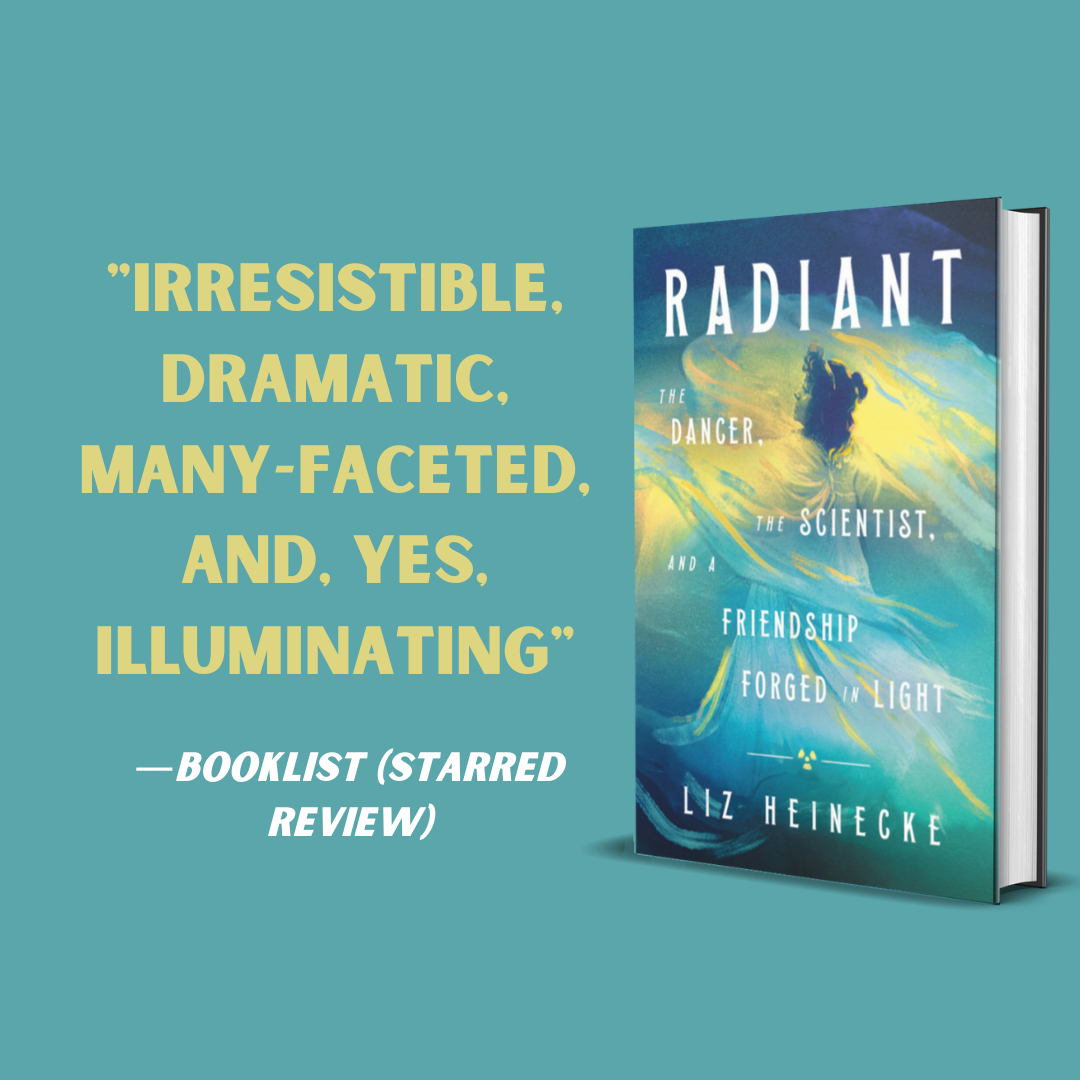liz lee heinecke
Author | Science Communicator
RADIANT, The Dancer, The Scientist and a Friendship Forged in Light
Part hidden history, part love letter to creative innovation, this is the true story of an unlikely friendship between a dancer, Loie Fuller, and a scientist, Marie Curie, brought together by an illuminating discovery.
Praise for Radiant
"...a unique, satisfying biography/creative nonfiction hybrid that celebrates the achievements of two women who revolutionized the artistic and scientific worlds. An illuminating book for fans of biography and popular science." ―Kirkus Reviews
"Radiant is the story of an unlikely friendship between two boundary-breaking women, each determined to bring some light into a dark world. A remarkable tale of science and art, beauty and loss, the power of the mind and the frailty of the body. Luminous."―Emily Anthes, Award-winning author of The Great Indoors
"Written at the vibrant intersection of science and art, Radiant details the fascinating lives of Marie Curie and Loïe Fuller. Both of these extraordinary women pursued their research with creativity and persistence, imagining radical new possibilities in their respective fields of chemistry and dance. Liz Heinecke's delightful book stages the story of their lively friendship within the proscenium frame of Belle Époque Paris."―Ann Cooper Albright, author of Traces of Light: Absence and Presence in the Work of Loïe Fuller
“With rich evocations of Belle Époque Paris and accessible introductions to the era’s artistic and scientific breakthroughs, this inspirational portrait of two trailblazing women soars.”
―Publishers Weekly
"Radiant is the absorbing story of two women moving through one another's orbits on the edge of their own singular legacies. In this fascinating story, Heinecke illuminates the individual work of Fuller and Curie along with their shared connection, leaving the reader with a sense of the fighting spirit they both held for their work, the people they loved, and life itself."―Amelia Gray, author of Isadora
"Radiant is an apt name for this book that illuminates subjects ranging from history to science and most especially, the lives and friendship of Loie Fuller and Marie Curie, two women who refused to let their genius and passion be thwarted by societal norms. An engaging, enlightening, and thoroughly entertaining read."―Lorna Landvik, bestselling author of Chronicles of a Radical Hag (with Recipes)
"Radiant is an uplifting story of discovery and friendship. Grounded in scientific and historical research, Liz Heinecke's book evokes the brilliance of Paris in the Belle Époque and delivers a timely reminder that even frustrated hope can produce enduring fulfillment."―Michael Joseph Gross, contributing editor, Vanity Fair
"Liz Heinecke's Radiant is a fascinating, exhaustively researched story about two women, scientist Marie Curie, and dancer Loie Fuller at the beginning of the 20th century in Paris. Both women broke through impossibly thick glass ceilings to become celebrated innovators. The two meet and an unlikely friendship is forged by both women's fascination with the possibilities of light. Radiant reads like a novel that you can't put down due to Heinecke's impressive prose and a gift for storytelling. I love this book."
―Laurie Lindeen, essayist and author of Petal Pusher
"Enchanting and informative, Radiant brings to light two critical figures at the turn of the 20th century: the world's first important female scientist, two-time Nobel-prize winner Marie Curie, and the mother of modern dance, Loie Fuller. This is a story of innovation and tenacity, beautifully conveyed by Liz Heinecke and chock full of scientific tidbits. Read this illuminating book, and you'll encounter Thomas Edison and Albert Einstein, and you'll understand why Marie Curie is one of our greatest scientists, why movie theaters are dark, and why you should travel (again) to Paris."―Dr. David Schneider, author of The Invention of Surgery
"Liz Heinecke expertly weaves the remarkable stories of two breathtakingly original women, Marie Curie and Loïe Fuller, into a superb book. Both women disrupted expectations and forged new paths in their fields and their friendship reveals the powerful connection between art and science at the turn of the 20th century. Radiant is compelling and vibrant."―Zeva Oelbaum, co-director of Obsessed with Light
Questions for book groups reading RADIANT
1. Compare and contrast the scenes in which we are introduced to Marie and Loie. What do they say about their shared traits, and their differences? Why do you think the author chose these moments to present them to readers?
2. Paris seems like the ideal backdrop for Loie’s innovative art and for Marie’s comparative scientific freedom. How important is landscape for shaping a person? What are examples you can think of from Loie and Marie’s lives? From your own?
3. It seems that both Marie’s father and Loie’s mother supported them wholeheartedly in their endeavors. How did each parent’s treatment of their daughters affect their trajectories? Do you think your parents had a similar effect on your life, whether they were a stern tutor like Marie’s father or a faithful companion like Loie’s mother?
4. Loie notes that she is often described as a “very pushing woman” but has never heard anyone described as a “very pushing man.” The has certainly been much progress since Loie’s time, but how can you see this insidious sexism persist today?
5. Why do you think Loie and Marie were drawn to each other? Have you felt under-appreciated at school or work? If so, how would finding someone with similar interests and mutual respect have affected your experience?
6. Why do you think the author chose to write Marie and Loie’s story now? How does their friendship and success bear on the state of female friendship and women in the workplace today?
7. One might think that Loie and Marie were in very different fields. In what ways do their goals in art and science respectively overlap? How do their similarities inform their work?
8. Why is cultivating friendships so important to Loie, as a person and as an artist? Do you think Marie would have had greater success faster if she was less reserved, or do you think her reservations served a useful purpose as a female scientist?
9. Loie’s work relied heavily on optical illusion, and as such she was often described as a “faker” due to the rigid conventions of her time. However, effectively “faking” is often considered the mark of a great performer. Given how vastly norms have shifted since Loie’s era, do you think what was an insult then could now be praise? How does Loie’s experience underscore the value of breaking from tradition?
10. RADIANT is centrally a story of powerful, determined, and intelligent women, but it is also a story of the importance of ally-ship. What are a few examples of people advocating for Marie and Loie when their voices were silenced by the establishment? How can we continue to strive towards equality by applying these lessons to our present day lives?
11. How were Marie and Loie received in each other’s home (or chosen-home) countries, as well as their own? Do you think their respective receptions indicates national feelings towards women, towards their professions, or both?
12. When the ills of radium become clear, Marie wonders if their work might have killed Pierre. Likewise, Louie partially blinds herself and may have given herself cancer from her work. Do you think the two would have continued their work early on if they had known the costs? Why or why not? What sacrifices would you be willing to make for your career or passion project?
RADIANT: Inside Edition interview
Here’s a fun interview I did with Inside Edition when “Radiant” came out. The video includes lots of great photos and I brought out my own miniscule piece of radium, in an antique spinthariscope, and demonstrated how uranium glass glows under black light! Watch the segment by clicking here.
From The Blog
April 1892
In April of 1892, Loie Fuller had begun performing her original Serpentine Dance at theaters all over New York City, including Madison Square Theater(New York Hoyt’s company), Palmer’s Theater and Madison Square Garden Concert Hall. By the end of the month, she’d added a flower dance to her repertoire. Unfortunately, her unique dance was so …
Contact Liz
lizleeheinecke@gmail.com

